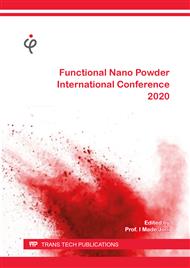p.113
p.121
p.133
p.143
p.153
p.165
p.171
p.181
p.191
Antimicrobial Activity of Calcium Hydroxide Synthesized from Indonesian Limestone against Enterococcus faecalis
Abstract:
Recurrent endodontic infections of treated teeth are mainly linked to microbial persistency in the root canal system. Enterococcus faecalis is a bacterium that is often identified in these recurrent infections. Calcium hydroxide (Ca(OH)2) is a widely used root canal medicament and is now being developed to be produced from natural materials. Ca(OH)2, which is synthesized from natural limestone from Palimanan, Indonesia, has a structure similar to Ca(OH)2, which is often used as a root canal medicament. The purpose of this study was to determine the antimicrobial property of Ca(OH)2 paste synthesized from natural limestone compared to conventional Ca(OH)2 paste. This study is an in vitro experimental study consists of 3 groups (n=24, namely, conventional Ca(OH)2 paste, limestone synthesized Ca(OH)2 paste, and saline as the negative control, for 2 intervals of time and evaluated by Total Plate Counting (TPC) method. Samples were mandibular first premolar root canal prepared by root canal preparation and contaminated with E. faecalis (ATCC 29212). The infected root canals of each group were treated by the medicaments, and samples from the root canals were taken on day 7 (n=4) and 14 (n=4). Results showed that both Ca(OH)2 groups had antimicrobial activities against E. faecalis. The limestone Ca(OH)2 paste group had the least amount of bacterial colonies on the 7th day compared to other groups. In contrast, on the 14th day, the conventional Ca(OH)2 paste had the least bacterial colonies. It can be concluded that the Ca(OH)2 paste synthesized from natural limestone has an antimicrobial effect on E. faecalis, the antimicrobial effect was higher on the 7th day but decreases on the 14th day, whereas the conventional Ca(OH)2 had a higher antimicrobial effect on day 14 compared to day 7. Further studies are expected to improve the long-term antimicrobial effectiveness and sustainability of the natural limestone synthesized Ca(OH)2 paste.
Info:
Periodical:
Pages:
171-177
Citation:
Online since:
August 2021
Price:
Сopyright:
© 2021 Trans Tech Publications Ltd. All Rights Reserved
Share:
Citation:


